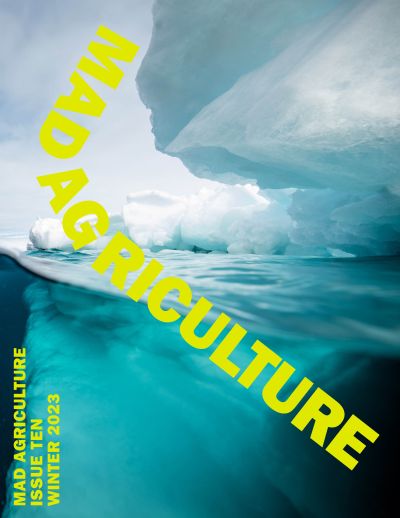
The Mad Agriculture Journal
A Conversation with Perrin James
Published on
January 24, 2024
Written by
Jonnah Perkins
Underwater photos by
Perrin James
Farm photos by
Angie Svinarenko
What happens when one of the most respected and sought after underwater filmmakers in the world takes his love for food and natural systems from the ocean onto land? When Perrin James, a Floridian, now rooted down on the Big Island of Hawaii, started his journey to creating a fully solar powered off-grid orchard and homestead on the slopes of Mauna Kea, he had no idea it would be so challenging. With the support of his neighbors and the tenacity he learned from building his career underwater, Perrin is now seeing the first fruits of his labor emerge.
Perrin caught up with Mad Media Producer, Jonnah Perkins, to talk about his path into diving, Hawaii food system injustice, what the ocean has to do with fruit trees, and why it feels good to be bad at things.
Jonnah: When I first got to know you, it was as an underwater filmmaker and photographer when we worked together on a project in Hawaii. I would love to hear your origin story of how you got involved in underwater filmmaking. Take me back to the beginning.
Perrin: We can take it all the way back there. I grew up in Florida and I used to go to the Bahamas with my parents. My father would always take me snorkeling in these different places. He always tells this funny story from when I was six or seven years old. I’d always hold onto my dad’s back and then one day he said, “You let go and you never came back and you just kept swimming.” My dad always jokes about it because before that day I was always stuck to him like an Opihi (mollusc that clings to rocks), and then one day I was like, I don’t need to hold on to you. I’m going out diving on my own.
The next year I had found a three-prong at a garage sale for $5 and it was one of those bright yellow ones. I feel like every person that’s ever dove has seen this yellow three-prong. They’re awful. They don’t work very well, but most divers have had one in their life. So I was an eight-year old with a slingshot underwater, and if you give an eight-year old a slingshot, he’ll probably kill something. But my dad’s rule was if you kill it, you have to eat it. And I was like, all right, well, that’s a good rule. I like this rule.
So I would go off the coast in the Bahamas by myself and I would go catch grouper and lobster–I would be swimming for hours. Then throughout my teens and high school, the ocean just became this giant escape for me. Learning in a traditional setting was never something I was good at and I’m still not good at that. I would skip school and I would go diving–that’s just how it’s been my whole life.
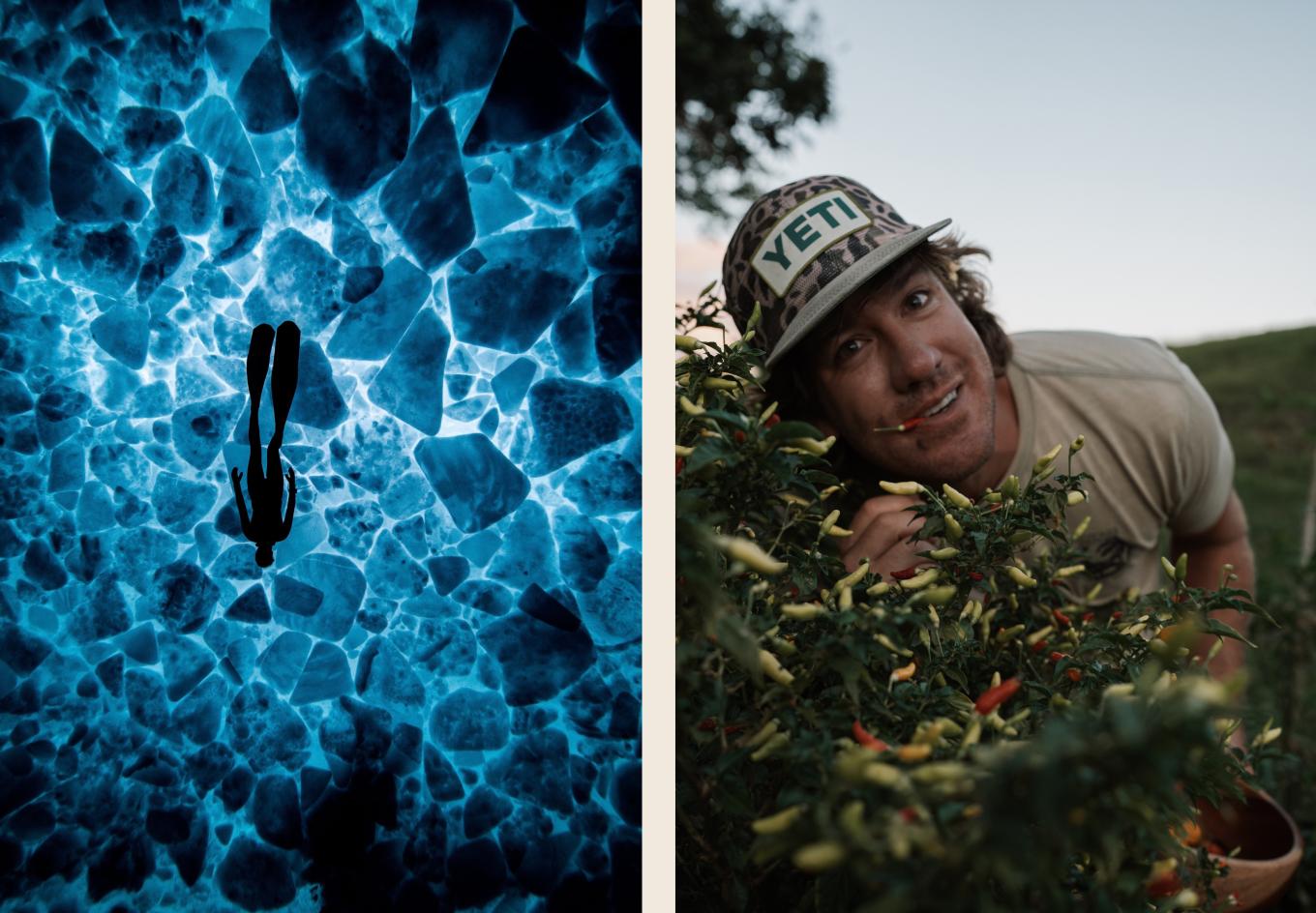
When I was 18 I was finding these little ecosystems in Fort Lauderdale, Florida, where I grew up. I was diving channels and bridges and all these really tidal dependent areas where it taught me how you can find clear water at certain times and when the water’s not moving fast, you could find different fish. So I was learning all these different variables that I still use today. I ended up finding these really cool places with snook and tarpon and maybe sometimes I’d see 30 eagle rays and just really, really cool aggregations of different fish.
When I told people they didn’t believe me. They were like, “You’re full of shit. That hasn’t been here in 30 years.” So I bought myself this little, I think an Olympus Tough 108820. It was this little point and shoot camera that could go underwater to 50 feet or something. I started taking it with me on my dives and I started posting all these photos of different sea creatures and fish that I was finding. That’s when I started getting asked to take professional photographers diving with me.
Those are still some of my favorite dive places. I ended up saving up for about a year and buying my first underwater camera. As soon as I bought that camera, that’s what I was going to do and I haven’t stopped shooting ever since.
Jonnah: Where in that journey did spearfishing come in and then the really big water deep underwater work that you do?
Perrin: At the beginning of my career, all I wanted to do was spearfish. From that point, I started making these spearfishing videos and kind of started this little cult following of spearfishing films. It was before social media and spearfishing was still in its very young stage of what it is now. It hadn’t blown up. There’s very few people in the world that were spearfishing and we all kind of knew who each other were.
Spearfishing is one of those sports that you just learn as you practice. You’re never the best, you just keep learning. So I started doing spearfishing for a couple years and making these films and it got to a place where I was traveling almost 300 days out of the year making spearfishing films all around the world from southern Indonesian oceans to South America to Africa. I think I was 23 or 24 and I mean, I had traveled to 20 or 30 countries just to go spearfishing and met people from all over the world that had taught me.
Things changed later on when I got burnt out on it, it became trophy hunting later on in my career where only very wealthy people would hire me to go to the most exotic places and shoot the biggest fish. It got to a point where people were just shooting five 200 pound yellowfin tuna in a day and in the most remote places in the world. To find an opportunity to even see an animal like that is incredible and then to want to kill five of them or 10 of them. It’s not necessary. You catch one and you can be stoked about it – that’s a lifetime fish.
To catch that fish, you’re going to drift in blue water for six to eight hours a day for a week, and you might get one opportunity in a normal situation, but we also discovered some places where you could find anything you could imagine was there. It was totally insane.
Jonnah: I am so glad that you had that realization around trophy hunting. For someone who doesn’t know, can you describe what blue water means and how it’s different from reef fishing?
Perrin: In blue water spearfishing, you’re looking for pelagic species of fish and you’re typically never seeing the bottom. Blue water is the most addictive kind of spearfishing because it’s just all wild cards of what you’re going to get. You think you’re going to see nothing because all you can see is nothing and then all of a sudden, the most delicious fish you’ve ever seen in your life swims straight up to you and you almost can’t believe it. At the same time, everything has to be calculated in the exact way you approach the fish and how you shoot the fish with your gear. Blue water spearfishing is not forgiving. It takes a lot of time and it is incredibly addicting.
I can’t even imagine how many hours I’ve spent floating around hoping something’s going to swim up to me. Then you have the process of once you shoot the fish, there could be sharks and trying to keep the sharks from eating the fish or even biting you is a whole other aspect.
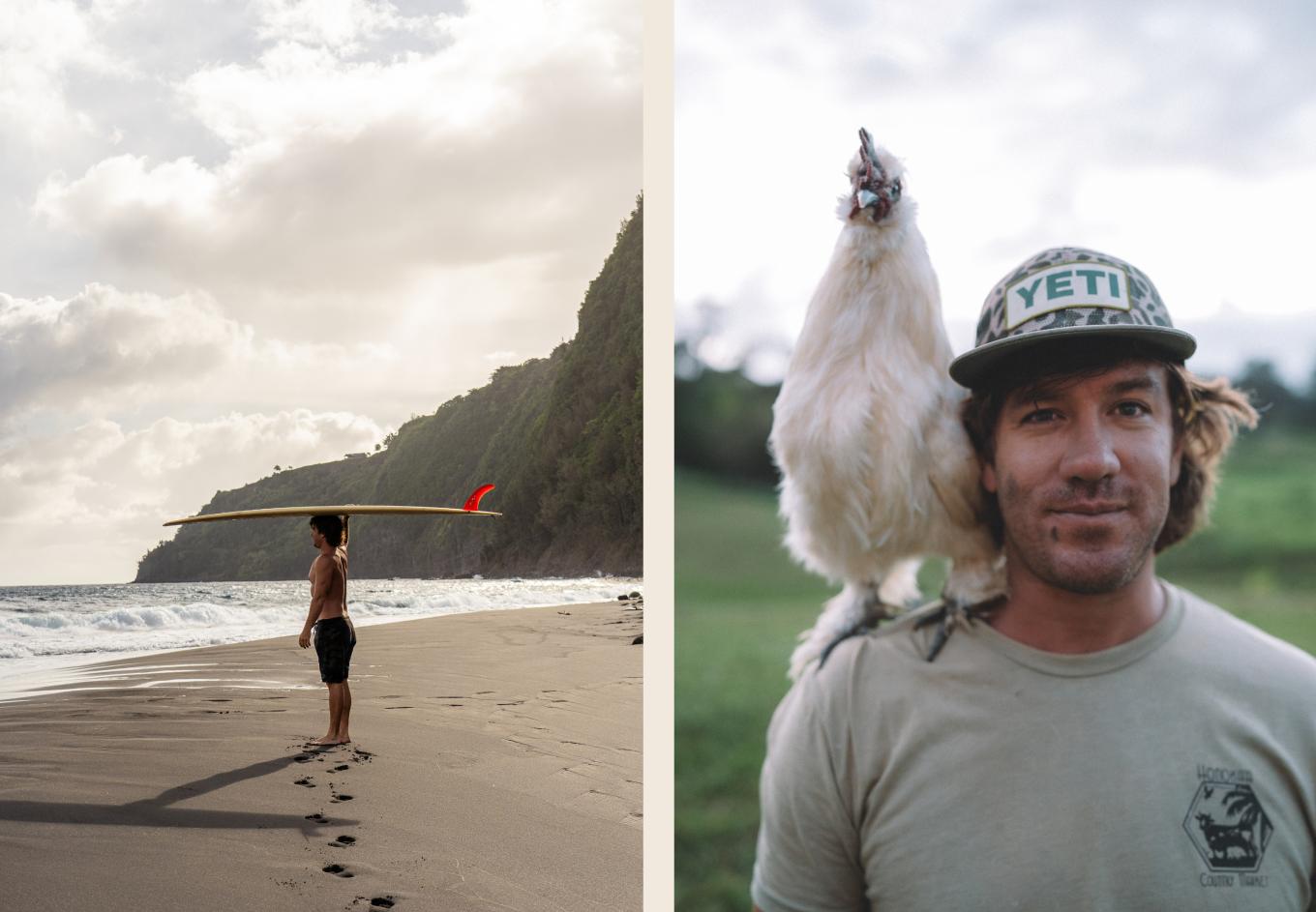
Jonnah: I understand just from such a limited experience in blue water with you that it is almost like manifesting something. You’re looking at the same shimmering blue and then all of a sudden the thing that you really wanted to happen upon is coming into your view. It’s hard to know if it’s real.
Perrin: Definitely. And the more blue water you do, I swear you start seeing fish that aren’t there. Maybe it’s just a shadow. You’re staring so hard into literally an endless blue and every little thing you see is a sign. Trying to find where a fish is in a vast blue where there’s very little signs of anything. You just have to pick up on all of these little things and then eventually you’ll find yourself in the right spot.
Jonnah: I know that you’ve traveled the world, you’ve done some really extreme things. What is your most impactful experience, whether they’re complete projects you did or just moments by yourself?
Perrin: One of the coolest things that my team has ever done was we were the first people to free dive with narwhals wearing wetsuits in the Arctic circle. I don’t think anyone has ever done that before, and I don’t think anyone’s done that since. That was 25 days of expedition with success in one day or two days. I felt like that was really a pinnacle in my career, but also a really difficult mental thing to overcome, just being freezing cold for so much time and waiting and planning and figuring out how to do something that there’s no guidebook for. I took everything I’d learned in my career from working with cetaceans and whales and trying to translate that in the Arctic Circle was very, very cool.
I try to do at least a couple different nonprofit projects a year and volunteer for conservation or humanitarian projects, whatever it is that I run into with my travels, when I feel like this story needs to be told. I worked on some cool projects in northern Indonesia for anti-shark finning stuff, which was really cool. Then recently we satellite tagged 15 striped marlin to follow their aggregation. All that scientific information’s going to come out I think in the next six months, which is very exciting.
Jonnah: I want to revisit these excesses in some spearfishing circles and tie it back to food. As humans, we are apex predators and many people on the planet, you and me included, have more food than we could ever need. How has your experience in spearfishing and your creative work, segued into this desire to be on the land in an agricultural setting? Was that one moment where you were struck with a desire to root down, or is that something that was growing over time in you?
Perrin: I can attribute a lot of this to my old place that I was renting before I purchased this farm. There’s this 80-year-old man that had planted trees for 40 years and I stayed in his guest cabin for five years. He never stopped working but he was always having fun. I was like I want to be strong and healthy when I’m super old. I was also drawn to the idea of being able to walk outside my front door and pick any fruit, just fresh, better than anything you could even buy at the store. That was the most alluring thing.
I catch all my own protein, whether it’s fish or venison or pork. I love to eat wild food and I was like, well, if I can catch all my protein, I should be able to grow the rest of it. And that was a pretty naive thought because I didn’t realize how hard farming is, especially from raw land.
Living in Hawaii, it’s so expensive and a big part of being able to afford this is being able to catch a lot of my own food. I would just like to not depend on any of our government or social provided food services because for the majority, in America, we are sold poison on a daily basis, which I don’t want to sound like a hippie ‘cause I’ll eat Cheetos all day long. I love Cheetos. But as soon as you cut out one thing because you can provide it and grow it yourself then it leads to the next thing. Then all of a sudden you’ve got chickens and goats and cows and you have all the trees and you’re like, well, I’m a full-time farmer. The whole thing is really rewarding, but also I never realized how much work it would be.
Jonnah: So what are the trees that you’ve planted, what’s working and what’s not? And how are you taking the lessons and evolving and what is the whole process?
Perrin: The process started with clearing five acres of waiwi (guava) with a chainsaw. Waiwi are an invasive tree in Hawaii. At that point I had never even used a chainsaw. Now I have three and I see myself as quite the chainsaw guy. What I’ve planted since then is a lot of windbreak trees. So the trade winds rip along the Hamakua Coast where I live and all the fruit trees really don’t like wind.
Next I planted endemic Hawaiian trees like ohia, koa, and kukui nut. Those trees give me the first stage in my forest and the majority of the trees’ purpose is actually just a block wind. The next thing I planted was citrus because I absolutely love lemons and limes and oranges and pomelos and grapefruits. So I planted a whole bunch of every single citrus that I could ever want. I’m also at this really strange microclimate that the 80-year-old man taught me about that lived on the old farm.
I’m at 1200 feet and in the wintertime I get thermal diurnal drafts off the mountain. There’s snow on Mount Mauna Kea and living on a volcano on the Big Island we get overnight wind chills of 40 degrees on the farm. I planted fruit trees like stone fruits, like apples, peaches and then also planted papayas and bananas. I think it’s such an incredibly interesting microclimate that you can grow stone fruit and bananas because I don’t think there’s that many places where you can do both. Being on a volcano, the soil is just insane for growing anything.
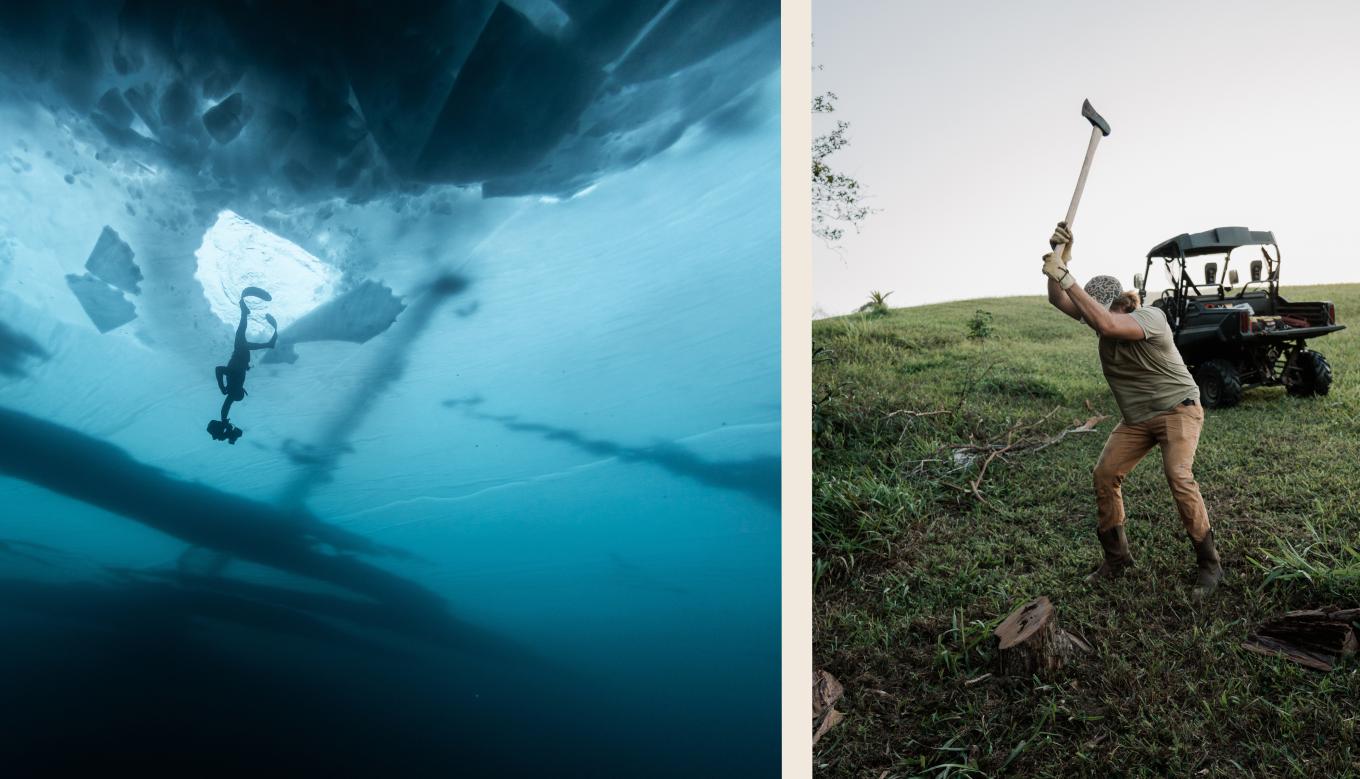
Jonnah: What is the largest or the most abundant crop that you have? Is there a tree that you’ve planted most of or a fruit that you’re particularly passionate about?
Perrin: There’s one tree that I want to plant the whole farm with, and that’s a mangosteen tree – it’s a fruit from Malaysia. It’s called the Queen of Asia. It is a little black purplish fruit that breaks apart like a cacao pod and you eat that or turn it into juice. I’ve planted a lot of mangosteen but they take between 9 and 15 years to fruit.
Jonnah: This perennial orcharding experience, has it changed the way you experience time? Are you thinking differently, like how old you’ll be when you see the fruits of this patience that you’ve had?
Perrin: It’s definitely taught me to slow down in my life. From traveling full time to having a farm that keeps me here and keeps me grounded has changed the way that I take care of myself because the farm work is so hard that I find myself stretching and working out just so I don’t get hurt doing farm work. There’s so many things I want to plan for my future that I just have no true certainty. We don’t have any certainty in what we’re going to do anyway, right? Life changes all the time, but I am going to take care of those trees for the next nine years – that I know. The only long-term goal I’ve ever had is trying to get my fruits to grow.
Jonnah: That’s so metaphorical and it sounds so literally grounding – these trees are growing in the ground. It gives comfort to the uncertainty that you know you’re going to be doing your best to take care of your trees.
Perrin: It’s been really fun to be really bad at something. In my career I’ve gotten to a place where I’m an expert at what I do and I’m really proud of that. My job is super chaotic, super dangerous, and there’s a lot of risk assessment that happens, but I’m good at it and I know what to do. In farming, all I do is break tools and I don’t know what I’m doing. It’s really interesting to learn about everything from soil diversity to having windbreaks and where to plant certain trees and how the rainfall works on elevation. I’ve gotten this knowledge from making friends with a lot of old people. From what I’ve learned, I think farmers and fishermen are some of the most reliable people in the whole world. I absolutely love the dirt aspect to a lot of these people.
They’re not in it for anything else besides they love to do it. And for the most part, farmers are kind people. I find myself in these two-hour long conversations with someone that’s in their seventies and eighties. Farming has made me step out of my comfort zone and learn new things and just be absolutely terrible at something. That has been really humbling.
Jonnah: You’ve spent so much of your life centered around the ocean, and now you’re just hurling yourself into this whole new land-based endeavor. Have you had any realizations around land ecology and ocean ecology and how they depend on one another?
Perrin: The rain is definitely something that I’ve learned to follow quite extensively. The farm is full rainwater catchment – I catch all the water that I use here on the farm. Aside from just catching water to keep the plants alive, planting things during different seasons has been the biggest thing I’ve learned and that has to do with our diving too. When the whales show up in late December or early January, the rain comes with the whales and with the whales comes big wahoo. Some of my favorite times of the year for spearfishing are also some of the best times for planting and putting new trees in the ground. It’s quite interesting because almost all of the wildlife in the ocean shows up at the same time, and then all the trees start to fruit as well.
We have these really cool seasons where August is mango and Ahi seasons. We have these fish species that follow different tree fruit times. I’ll look at a tree and I’ll see it start to blossom and I know that fish is going to be here this week because my fruit tree is blossoming. A lot of the Hawaiian calendars actually relate to what’s going on in the mountain to what’s going on in the ocean. When I first started following this it actually made a lot of sense – it’s interesting to watch fish migrations follow fruiting seasons.
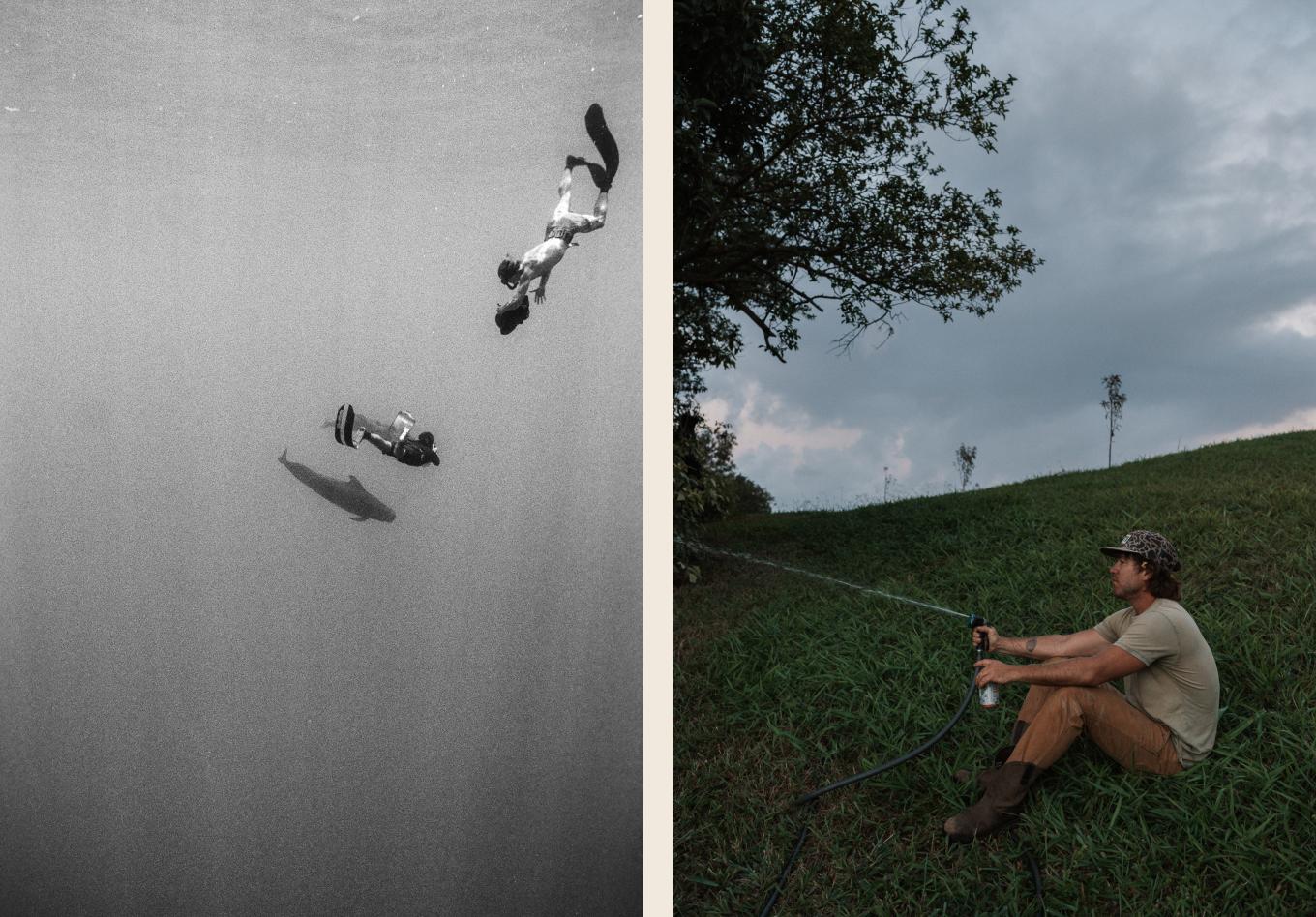
Jonnah: That is so interesting. I didn’t know that, but it totally makes sense and I love that you’re now living in the calendar. You’re a part of that calendar.
Let’s talk about the Hawaiian food system and where you see the need for reform. What are some of the issues you face in supply chain independence?
Perrin: 85-90% of the food in Hawaii is imported from the United States, and that makes no sense whatsoever. Hawaii could be 100% sustainable as it was before Europeans arrived. A lot of that is due to corruption from import/export laws. We still follow the Jones Act, which means we pay an extra 25% on almost everything imported and that is to keep US-made ships. When we order something, it has to go to California first before it can come to Hawaii because it has to come on a US boat. That is 100% monopoly and corruption. If you drive around the Island all you see are cows up here but you can’t go buy it at a store. Same with avocado. I mean the Big Island alone could probably provide enough food for all of the Hawaiian Islands but farmers can’t sell directly into stores.
Jonnah: It doesn’t make any sense, and it also seems like it holds Hawaii in this strangle, creating this dependency that feels very perilous and scary. Like what if you were cut off from the mainland?
Perrin: On O’ahu, not this island, there’s enough food for the people on the islands for two weeks. So if boats ever stop coming to Hawaii, there’s enough food for a million people or over a million people for literally two weeks, which is a pretty terrifying number. Also, again, it doesn’t make sense because we can grow everything on the volcanic soil that we have, but I think it comes back to convenience and price and you can’t fight against monocropping giant corporations that poison their food just for price.
Jonnah: A friend of mine showed me this illustration of the traditional Hawaiian food system that had to do with aquaculture along the shore and then up the coast there’s these different crops depending on the altitude, and then the water was channeled down. It was this whole beautiful circular food system that was totally disrupted during colonization.
Perrin: The Hawaiians, they had it figured out from mountain to ocean to fish pond and where the water would run down from the ocean, it would feed the fish pond and it was completely sustainable and regenerative. It’s interesting that you bring that up because right now on the Hawaii political front, there is a massive push to restore ancient water rights. Where water should be because you have things like Lahaina, an entire city burning down, and a lot of that comes down to stolen water and turning a wetland into dry land. Lahaina used to be a wet place and it burned down because of stolen water.
Jonnah: Yeah, draining wetlands and moving natural water holding capacities is so problematic. It’s problematic for flooding and it’s problematic for fire. We have so many examples of why not to fill in wetlands. Yet developers can’t help themselves but try to profit in these quick and dirty ways that continue to create a lot of destruction and a lot of pain for people and animals and the entire ecosystem.
On a lighter note, what are you fishing for right now? And does that tie in with what you have going on on the farm?
Perrin: Next week I’m planning on diving in some of the zones that become too dangerous after September. I’m going to go out and look for kole maybe some mu, which is a yellow eye sturgeon. I’ve been addicted to blue water for the last couple months. I’ve been getting mahi-mahi and onos and yellowfin, and I’m craving some reef fish and I think my banana trees might be craving some reef fish too.
So I’m going to go catch some local fish and I’m going to plant some new bananas.
Jonnah: Do you use any of your fish like byproducts for fertilization?
Perrin: The fish goes into my main compost. I can put it in when I plant but it’s got to be deep underground otherwise the wild pigs will come and eat the fish.
Jonnah: What is the next meal you’re excited about making with fish?
Perrin: I’m going to steam some fish and I’m going to fry some fish. I’m going to fry the smaller koles and then pachis because they’re just crispy, little delicious fish bites.I’m going to steam the mu, with a ginger soy sauce kind of chimichurri, like a chimichurri ginger sauce for the fish.
Jonnah: I wish I could be there. I’m so personally so excited for you. It’s amazing how vulnerable you’ve been about it and leaning into not knowing what you’re doing but enjoying the whole difficult process of it.
Perrin: It’s been a very fun learning experience and I’m excited to keep planting all these trees and it’ll be interesting once it turns into a forest. Someone told me this the other day, it was so good. Year one, they sleep, year two, they creep. year three they leap. That’s what they do. And I’m coming up on year three and some of my lemons and limes are fruiting for the very first time. As soon as we get to the rainy season, all of my trees are going to fruit for the first time and I’m very excited about that.
